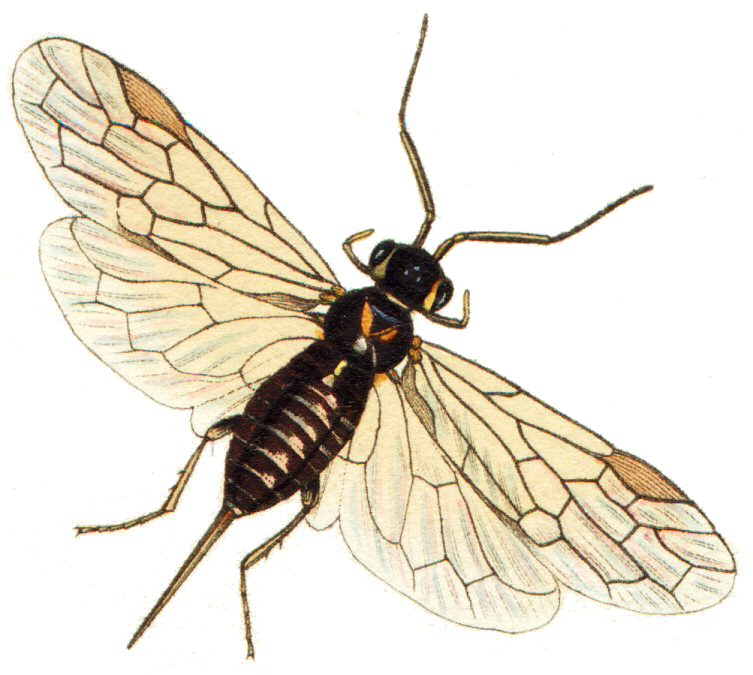|
Stephanoidea
Stephanoidea is a superfamily of parasitic wasps within the Apocrita, it includes only one living family, Stephanidae (350 living species mid Cretaceous-recent), as well as the extinct families Ephialtitidae (89 species, Early Jurassic-mid Cretaceous), Aptenoperissidae (8 species, mid Cretaceous, Burmese amber Burmese amber, also known as Burmite or Kachin amber, is amber from the Hukawng Valley in northern Myanmar. The amber is dated to around 100 million years ago, during the latest Albian to earliest Cenomanian ages of the mid-Cretaceous period. ...), Myanmarinidae (4 species, mid Cretaceous, Burmese amber) and Ohlhoffiidae (4 species, Early-mid Cretaceous). References {{Taxonbar, from=Q15260261 Apocrita Insect superfamilies ... [...More Info...] [...Related Items...] OR: [Wikipedia] [Google] [Baidu] |
Stephanidae
The Stephanidae, sometimes called crown wasps, are a family of parasitoid wasps. They are the only living members of the superfamily Stephanoidea. Stephanidae has at least 345 living species in 11 genera. The family is considered cosmopolitan in distribution, with the highest species concentrations in subtropical and moderate climate zones. Stephanidae also contain four extinct genera described from both compression fossils and inclusions in amber. Biology Stephanids are noted for their ocellar corona, a semicircular to circular set of projections around the middle ocellus, forming a "crown" on the head. Only stephanids and the similarly old Hymenoptera family Orussidae have ocellar coronae, and it is uncertain if they developed the structure separately or if a common ancestor of both developed it and it was then lost in all but the two families. Weakly developed grooves starting at the base of the antennae and extending past the eyes to the back of the head capsule are present ... [...More Info...] [...Related Items...] OR: [Wikipedia] [Google] [Baidu] |
Aptenoperissus Burmanicus
''Aptenoperissus'' is a genus of extinct wasp with eight described species, placed into the monotypic family Aptenoperissidae. The type species ''Aptenoperissus burmanicus'' resembles a mix between a grasshopper, an ant, and a wasp. It was described by a group of researchers from Oregon State University in a paper released online in October 2016. The piece of 100 million year old Burmese amber that it was preserved in was found in the Hukawng Valley of Myanmar in Southern Asia. A new family, Aptenoperissidae, was described to accommodate this insect. Species of ''Aptenoperissus were'' wingless, with a strong stinger. The creature had long legs making it perfect for jumping higher than most insects. Subsequently additional species were described from the Myanmar amber: ''A. amabilis'', ''A. delicatus'', ''A. formosus'', ''A. etius'', ''A. magnifemoris'', ''A. pusillus'' and ''A. zonalis''. Initially placed in Ceraphronoidea, later studies placed it in Stephanoidea Stephanoidea i ... [...More Info...] [...Related Items...] OR: [Wikipedia] [Google] [Baidu] |
Aptenoperissidae
''Aptenoperissus'' is a genus of extinct wasp with eight described species, placed into the monotypic family Aptenoperissidae. The type species ''Aptenoperissus burmanicus'' resembles a mix between a grasshopper, an ant, and a wasp. It was described by a group of researchers from Oregon State University in a paper released online in October 2016. The piece of 100 million year old Burmese amber that it was preserved in was found in the Hukawng Valley of Myanmar in Southern Asia. A new family, Aptenoperissidae, was described to accommodate this insect. Species of ''Aptenoperissus were'' wingless, with a strong stinger. The creature had long legs making it perfect for jumping higher than most insects. Subsequently additional species were described from the Myanmar amber: ''A. amabilis'', ''A. delicatus'', ''A. formosus'', ''A. etius'', ''A. magnifemoris'', ''A. pusillus'' and ''A. zonalis''. Initially placed in Ceraphronoidea, later studies placed it in Stephanoidea Stephanoidea i ... [...More Info...] [...Related Items...] OR: [Wikipedia] [Google] [Baidu] |
Apocrita
Apocrita is a suborder of insects in the order Hymenoptera. It includes wasps, bees, and ants, and consists of many families. It contains the most advanced hymenopterans and is distinguished from Symphyta by the narrow "waist" ( petiole) formed between the first two segments of the actual abdomen; the first abdominal segment is fused to the thorax, and is called the propodeum. Therefore, it is general practice, when discussing the body of an apocritan in a technical sense, to refer to the mesosoma and metasoma (or gaster) rather than the "thorax" and "abdomen", respectively. The evolution of a constricted waist was an important adaption for the parasitoid lifestyle of the ancestral apocritan, allowing more maneuverability of the female's ovipositor. The ovipositor either extends freely or is retracted, and may be developed into a stinger for both defense and paralyzing prey. Larvae are legless and blind, and either feed inside a host (plant or animal) or in a nest cell provi ... [...More Info...] [...Related Items...] OR: [Wikipedia] [Google] [Baidu] |
Burmese Amber
Burmese amber, also known as Burmite or Kachin amber, is amber from the Hukawng Valley in northern Myanmar. The amber is dated to around 100 million years ago, during the latest Albian to earliest Cenomanian ages of the mid-Cretaceous period. The amber is of significant palaeontological interest due to the diversity of flora and fauna contained as inclusions, particularly arthropods including insects and arachnids but also birds, lizards, snakes, frogs and fragmentary dinosaur remains. The amber has been known and commercially exploited since the first century AD, and has been known to science since the mid-nineteenth century. Research on the deposit has attracted controversy due to its alleged role in funding internal conflict in Myanmar and hazardous working conditions in the mines where it is collected. Geological context, depositional environment and age The amber is found within the Hukawng Basin, a large Cretaceous- Cenozoic sedimentary basin within northern Myanmar. ... [...More Info...] [...Related Items...] OR: [Wikipedia] [Google] [Baidu] |
.png)

